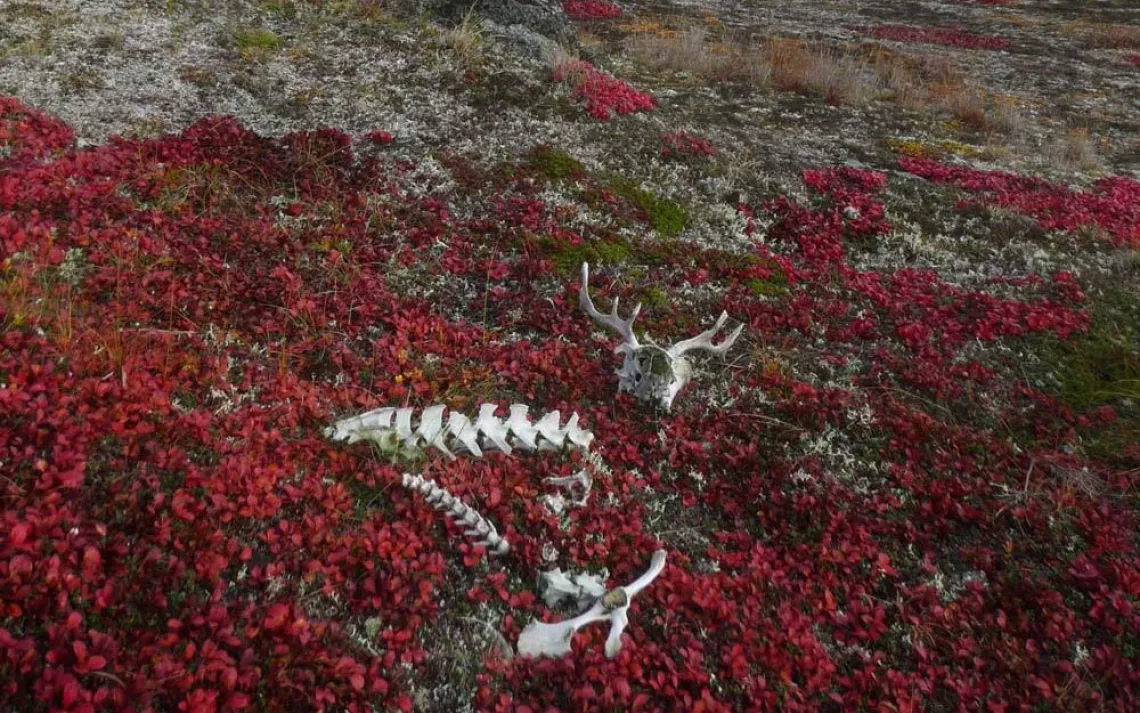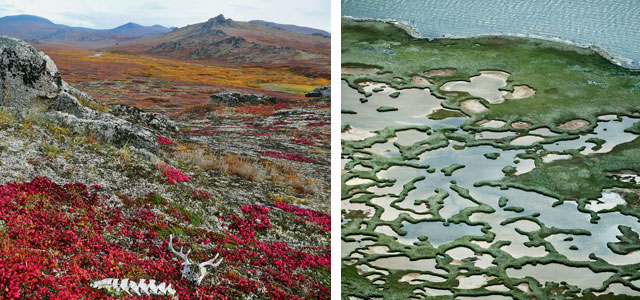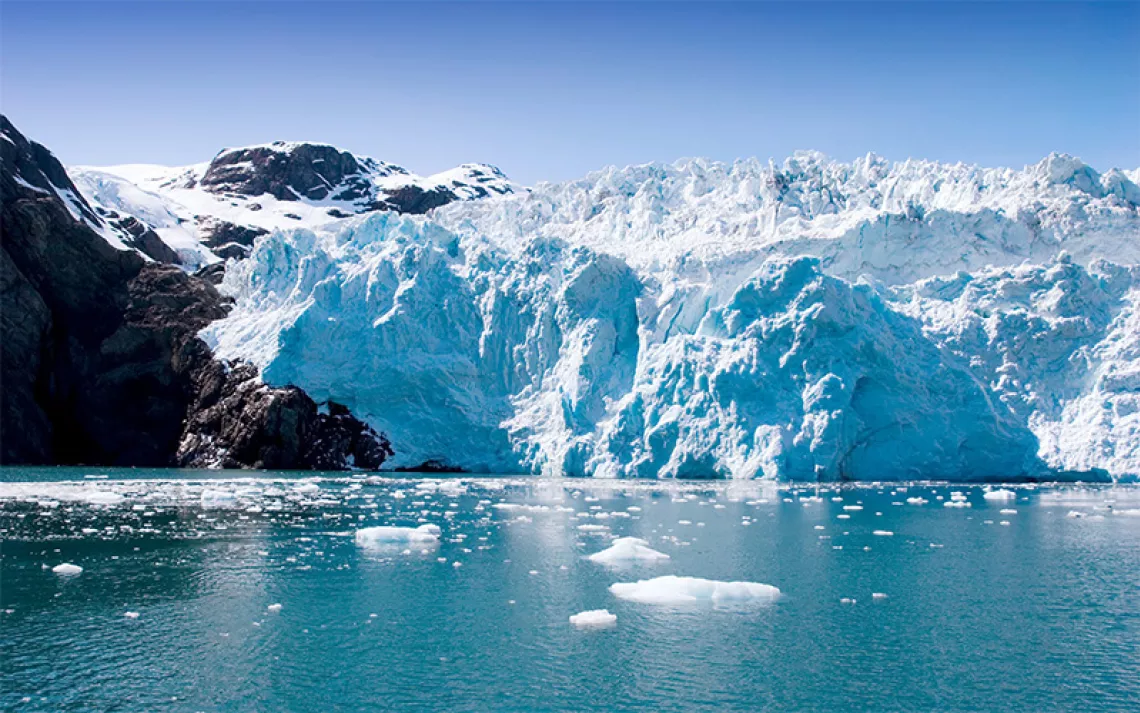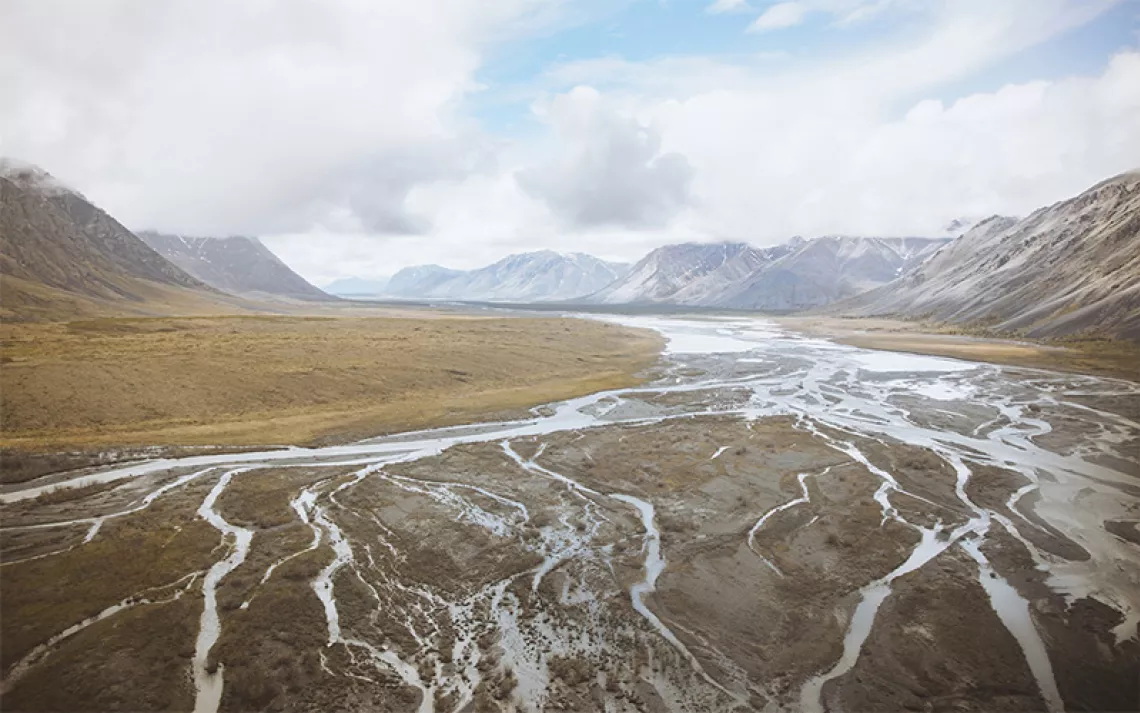In Beringia
Searching the Arctic for a long-lost world of woolly mammoths and giant sloths, a traveler discovers a new one disappearing fast

A caribou skeleton near Serpentine Hot Springs. | Photo courtesy NPS.
ON THE ROAD FROM NOME TO TELLER, ALASKA, all the musk oxen have moved up the hills, trying to turn back time and seasons with a change of altitude. But reindeer, descendants of a herd imported by a misguided but well-meaning missionary more than 100 years ago, completely block my way. The clicks of their anklebones, the shake of muscle, sound like sleigh bells. They trot toward the truck until they're close enough for me to smell them—it's like fresh blueberries mixed with dryer lint—and then all turn at once, giving up the hard-packed dirt for the tussocky tundra. Within yards, their autumn-mottled fur looks ghostly against the landscape.
I'm on this road, an off-ramp of what used to be the Bering Land Bridge, because in 1901, on the other side of the Bering Strait—way past where long-tailed jaegers hover like broken kites—a man named Otto F. Herz dug up a woolly mammoth.
Back then that wasn't so unusual in Alaska, Russia, and the Yukon Territory. In fact, so many mammoth bones and tusks were found during the Klondike gold rush that someone built a cabin out of them. Herz's find was different, though: not a skeleton but almost an entire animal preserved in permafrost.

Two faces of Alaska's Bering Land Bridge National Preserve: a caribou skeleton near Serpentine Hot Springs (left) and the quickly eroding Chukchi Sea coastline, not far from the vanishing seaside village of Shishmaref.
And so now I'm on an off-ramp to the Bering Land Bridge, because when they looked closely, the mammoth still had a mouthful of buttercups.
But the very phrasing is wrong, a lie. "The Bering Land Bridge," they told us in grade school. And everybody I've ever talked to pictured pretty much the same thing: a strip of land, maybe just wide enough for three or four people to walk abreast, reaching out from Asia to America like the finger of God on the ceiling of the Sistine Chapel.
The Bering Land Bridge wasn't a bridge at all, though; it was simply dry land where the shallow Bering Sea is now. As many as 600 miles from north to south, it didn't connect two continents but rather created a single place, Beringia, an environment that stretched from around the Lena River, in what's now northeastern Siberia, to the Mackenzie River, roughly the current border of Canada's Yukon and Northwest Territories. Along the way, it more or less straddled the Arctic Circle.
COMPLETELY SURROUNDED BY GLACIERS, Beringia was a contained, warmer world of ground sloths the size of cars, of woolly mammoths and lions and scimitar cats with teeth curved as if drafted by a protractor. Small horses darted through low grass. And here, the first people walked from what we now call the old world to the new. But there could have been no sense of arrival, because at the time there was only one world.
Think of that lovely phrase from Thoreau: "I wish to know an entire heaven and an entire earth." That was Beringia.
Then, about 10,000 years ago, the glaciers melted. The temperature warmed. The sea filled. And the last entire earth disappeared.
A DOZEN YEARS AGO, when I first came to Beringia after reading about Herz, I walked into the Bering Land Bridge National Preserve office in Nome and said, "I need a mammoth." For some reason, that made perfect sense to the ranger. He took me into a back office where a tusk lay, about five feet long, as thick as a baseball bat at one end, tapering to a fine point at the other. When the mammoth was alive, the tusk was a clean ivory. But over the past 10,000 to 40,000 years, it has absorbed minerals and traded molecules and turned pale blue, like a powdery sunset gleaming against a glacier.
The blue is a fairly basic chemical reaction: The mineral vivianite likes it when the organic remains of animals, which are low in iron and high in phosphates, end up buried in soil that's rich in iron and phosphate-poor. Mix in oxygen, get the blue—one of those rare occasions when time and loss conspire to add beauty.
"Okay, here's what you're going to do," the ranger said. "Right after spring breakup, get a thirty-ought-six. Then walk the streambeds. Look along the line where the ice has stripped away the banks. Sooner or later, you'll see a bone or a tusk sticking out. Shoot all around it to loosen the permafrost." Then he realized I was writing this down, and I had his name. "I'm going to need my business card back," he said.
And so, year after year, I've gone back. I've walked streambeds in Beringia. I've traveled from the edge of the Yukon to the Bering Sea. I've interviewed every expert I could get to spare a few minutes of time. The short and easy reason is that I'm hoping that no world is ever completely lost. The longer, more complicated reason is that, despite all hope, I know I'm watching a world disappear, and I can't take my eyes off it. Each trip has revealed a landscape changed. It's as if I'm watching a horror film on fast-forward. Rivers I walked alongside a decade ago that had no plants on the banks higher than the blueberries staining my shoes are now lined with willows too tall to see over.


Beringia today (above) and 18,000 years ago (below). Melting glaciers and rising oceans expanded the Bering and Chukchi Seas and severed the terrestrial link between Asia and North America. | Maps by Michael Newhouse
Just as the thaw of the last ice age changed Beringia, the new round of warming is changing it again. Last time it was the glaciers that melted; this time it's the very ice beneath the earth, the permafrost. We know what's happening, and we know why it's happening: a compounding of every plane I've taken to get up here, every light switch I've ever flipped on in my life. But the effect means that walking this landscape is like walking a scrim, present and past laid over each other, different worlds matching all too closely. The ancient one gone forever, the present one disappearing fast.
So very fast. The rise of the Bering Sea destroyed one world and is working hard on covering another; the effects of global warming might be more visible here than anywhere else on the planet. Already, the residents of Shishmaref, an Eskimo village off the north coast of the Seward Peninsula and a puddle jump from the Bering Land Bridge National Preserve, have had to start packing up to move to the mainland, as rising seas chew away at their island—a move that experts estimate could cost up to $200 million. And Shishmaref is just the beginning, the poster child; the U.S. Army Corps of Engineers has identified 26 Alaskan communities that have erosion severe enough to require immediate government intervention.
The effects of climate change stretch beyond the coast and all across Beringia. A few years back, I had a chance to camp in Vuntut National Park, Canada's side of the Arctic National Wildlife Refuge, near the eastern edge of Beringia, with Gwich'in elders. (See "A Real Refuge," March/April 2006.) Hills rolled away, stretching forever; the valleys between filled with lambent light. The elders told stories of when the caribou herds were a mile wide. But for us, the caribou didn't show, and as we waited longer and longer, the stories stopped. After a while, nobody said much of anything at all.
TODAY, THE MUSK OXEN HAVE MOVED UP into the mountains, because it is simply too warm for them to be browsing the lowlands the way they normally would.
I drive north through the ox-less landscape. The official Bering Land Bridge National Preserve is north of Nome, but the road doesn't go anywhere near that far, and the only person willing to fly me out there wanted $25,000. Besides, as even a ranger at the preserve's office in Nome said, "without a geographic center of Beringia, we're as close to it as you're going to get." So really, any direction I go, I'm there.
Among scholars, Beringia is a surprisingly modern idea. The region's earliest explorers did notice that the two sides of the Bering Strait seemed to have a lot in common, and of course, the natives, who paddled back and forth across the waterway, already knew that. In the 1920s, Eric Hulten, who was studying plants in Kamchatka, started identifying species and mapping their locations. In the 1940s, David Hopkins did some of his own fieldwork and began putting the puzzle pieces together.
But it was University of Alaska paleobiologist Dale Guthrie who began to figure out what the original Beringia had been like and how it had changed. He studied the frozen gut contents of woolly mammoths preserved in Siberia and plant macrofossils from the molars of other megafauna and found that 75 percent of the animals' diets had been grass. Horses' molars showed that they had eaten 40 percent grass and 40 percent woody plants. In other words, they were grazers, and very little of what's there today is grazing territory.
Or, as Guthrie told me, "So I came up with this cockamamy idea that I couldn't get published." That an entire world had been replaced.
Guthrie coined the term that some academics use now for ancient Beringia: the "mammoth steppe." Continued analysis shows that there's no place like it on Earth anymore; that it was, according to Guthrie's book Frozen Fauna of the Mammoth Steppe, "a very complex amalgam of what we see today in quite separate communities, both on small and large scales."
For instance, in 1979, Guthrie got a chance to excavate the Alaskan equivalent of Herz's mammoth: Blue Babe, a preserved, vivianite-blue steppe bison exposed when a gold miner blasted away at a hillside with high-pressure water. Guthrie's necropsy showed that the bison had been killed by a lion, an animal that in the 1970s wasn't believed to have lived in Alaska. But the tooth marks couldn't have been from anything else. Blue Babe had been "taken down by the snout" and suffocated—which is what African lions do to buffalo even now.
While Guthrie has been digging up Beringia, a guy named Sergey Zimov has been trying to re-create the place on 10 square miles in the middle of Siberia. Never mind that he doesn't have any mammoths handy, that the steppe bison are long gone, that nobody has seen a giant ground sloth or a scimitar cat or a beaver the size of a coffee table in quite a while. He's doing the best he can, bringing musk oxen, bison, and yaks into Pleistocene Park. Eventually, he might even get his mammoth, or a reasonable facsimile, as Japanese scientists are trying to clone woolly mammoths with DNA from frozen carcasses and the eggs of modern elephants.
Zimov's challenge, said paleoecologist Mary Edwards, is that the once-dry steppe has become maritime tundra. "You look at a satellite photo now and see that lakes of all sizes dominate the nonglacial landscape," she said. "Change the ice sheets, and you change the rivers and fill up lakes. Tundra in the northern places is very wet. Water stays on the land, everything gets wetter, and that's not good for critters with tiny feet."
Even as the landscape is changing daily because of global warming, it remains "the last unspoiled stretch of our world, because humans never had much impact," according to David Klein, a wildlife ecologist at the University of Alaska Fairbanks's Institute of Arctic Biology. "The changes in the Holocene [the Beringian melt period] were climate, which changed the animals, which changed the people," Klein said. Not the other way around.
THE BERING SEA LIES MIRROR-FLAT. I've left Nome and, after a seriously roundabout route, come to the Pribilof Islands. These islands were once hills on a plain and tall enough to reach above where the sea is now. St. Paul, St. George, and a couple of smaller islands are all that's left of what once connected an entire world. I've come to stand on the actual Bering Land Bridge.
This also happens to be one of the last places where mammoths walked Beringia, and St. Paul contains the remains of one. At around 5,000 years old, they're the newest bones I'll ever have a chance to see.
I seem, though, to be the first person ever to come here for the mammoth. The few other people who make it to the Pribilofs through the fog come to work a crab boat or to see rare birds. I'm okay with the birds, and it amuses me that for the rest of my life I'll be able to make serious twitchers cry in envy because I've seen a red-legged kittiwake, which breeds almost nowhere but here. (For the record, they look just like every other kittiwake in the world, but with red legs.)
Everybody's happy to talk about birds. But nobody wants to tell me about the mammoth, and the locals evade the question of exactly where it is. I hear a rumor that it's on airport property, but I'm warned that if I go out looking on my own, I'll probably fall into a lava tube and never be heard from again. I have to admit that has an odd appeal, the idea of someone stumbling across my bones 5,000 years from now and wondering what the hell I was up to.
Every place I stop on the impossibly green island, fur seals bark at me. Some of the adolescents make false charges, but never more than a token lunge. They are surprisingly gentle, especially considering that St. Paul was the center of fur sealing for 100 years and countless seals were slaughtered here. On one end of the island is a sand drift, 50 feet high, and anywhere you push your hand into it, you'll grab bones.
Ten years ago, long after the sealing had stopped, more than a million fur seals would come to the island each year to breed. Now the island sees maybe a quarter of that number, and, like the Gwich'in waiting for the caribou, nobody thinks the rest are coming back. The water's gotten too warm, and the southern fish species now invading the Bering Sea have altered feeding patterns; the seals can't find the fish they're used to. And lately, a woman with traditional Aleut facial tattoos tells me, there aren't even many orca offshore waiting to snack on young seals.
Meanwhile, shipping in the Bering Strait is increasing, and there's more drilling in the warmer Arctic. Migration patterns are being disrupted, even for the animals that can still take the weather. And as the thermometer ticks up, the navigator's dream of an open Northwest Passage comes ever closer to reality, and the people in a place where there have never been enough people to matter are about to be joined by a whole lot more folks.
Which still leaves the question of the last mammoth, which I never do get to see, never even get close to. What the hell was it up to? What lured it here, like Hemingway's leopard on Kilimanjaro? Was it following the taste of a flower patch or simply searching for a taste it remembered and couldn't find anymore? Was it trapped by rising water as its world disappeared? Was it looking for a last spot to ride it out?
"Perhaps it is not coincidental," writes the surprisingly poetic Beringian scholar Savelli V. Tomirdiaro, "that in the Biblical and Sumerian legends the Flood may be ascribed to a period of the early Holocene. . . . In the Arctic, a vast, super-marine landmass . . . comparable in size to some continents did, indeed, simply vanish by melting."
I SIT ON A WHALE RIB BONE, push up my sleeves in the sunshine, and stare into the slowly rising sea.
Somewhere between Nome and Teller, a three-street village on another shrinking sandspit where salmon are hung to dry on satellite dishes, I walk into Beringia.
Lichens that look like the smudge of burned rubber grow along the line of the sun. The rivers that were formed when the bridge disappeared are full of dying salmon, and the rocky streams play stones like the notes of a concerto. The wetter world. Birds that wouldn't have been here 5 years ago flit through bushes that wouldn't have been here 10 years ago. Mushrooms with warty nodules across their tops tower over saxifrage, and bones are never more than a few feet apart. Reindeer bones, mink, musk oxen, bear—only the tiniest fraction of the diversity that once filled the mammoth steppe.
I walk, thinking about how Dale Guthrie has lately been looking at paleolithic art, the way mammoths and bison and other Beringian animals were drawn on caves, carved on rocks. And what he's found are animals painted at all different stages of life, in all conditions, in nearly flawless detail, right down to the upright fighting posture of the mammoths.
"These Paleolithic people had to know large mammals well, almost as extensions of themselves," Guthrie said. "When how you live is resource-based, you have to be wholly encyclopedic."
After spending more than 10 years in this landscape, I'm still far from encyclopedic. I can't even name half the plants I'm stepping on—neither the ones that should be here nor the ones that shouldn't. We've lost that fine and necessary discrimination; we're not resource-based anymore. How many people can name half the plants outside their front door?
I do know that the next time I come here, the trees will be taller, the streams wider, and maybe even the taste of the carpet of Arctic blueberries—what sunshine would taste like if it were edible and blue—will be different.
I started coming here because I wanted to understand if there could be gain in loss. And even as I watch the cracks in the last entire earth widen, it's still so very beautiful.
One world is gone; this one is going fast.
And my mammoth is still out there somewhere. The ever-rising vivianite sea at my back, I walk deeper into Beringia. If I get high enough into the mountains, I might at least find a musk ox browsing on buttercups.
 The Magazine of The Sierra Club
The Magazine of The Sierra Club



